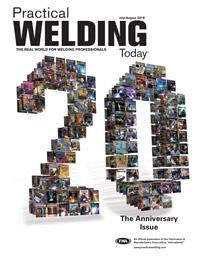Independent welding consumables professional
- FMA
- The Fabricator
- FABTECH
- Canadian Metalworking
Categories
- Additive Manufacturing
- Aluminum Welding
- Arc Welding
- Assembly and Joining
- Automation and Robotics
- Bending and Forming
- Consumables
- Cutting and Weld Prep
- Electric Vehicles
- En Español
- Finishing
- Hydroforming
- Laser Cutting
- Laser Welding
- Machining
- Manufacturing Software
- Materials Handling
- Metals/Materials
- Oxyfuel Cutting
- Plasma Cutting
- Power Tools
- Punching and Other Holemaking
- Roll Forming
- Safety
- Sawing
- Shearing
- Shop Management
- Testing and Measuring
- Tube and Pipe Fabrication
- Tube and Pipe Production
- Waterjet Cutting
Industry Directory
Webcasts
Podcasts
FAB 40
Advertise
Subscribe
Account Login
Search
Consumables Corner: Choosing the correct filler metal for mismatched base materials
- By Nino Mascalco, Rob Koltz, and Steve Sigler
- July 22, 2016
- Article
- Consumables
Q: We're a small shop that builds and welds a lot of custom metal products. In many instances, the products are made from two or three different material combinations, including stainless steel at times. Is there a good rule of thumb for deciding the correct filler metal to use?
A: That is a pretty common question, and a lot of information is out there, but sometimes sorting through it all for the answer can be daunting. Here are some guidelines that should help you make the right choice.
The first thing you want to determine is how much welding is required for the job, which welding positions will be required, and the type of weld joint access. This will give you an idea of what welding process you should use.
Let's start by looking at the situations involving stainless steel since it's probably the most straightforward answer. If you are welding stainless steel to stainless steel, you will have to look at the type and match the filler metal accordingly and to its in-service conditions.
In general, if you are welding stainless steel to carbon steel, you will more than likely want to use some version of 309 filler metal. If you choose a solid-wire electrode (GMAW), the shielding gas can be one of many types, but typically it will be 95 percent or more argon (Ar) balanced it with carbon dioxide (CO2), oxygen (O2), or helium (He). If you choose flux-cored arc welding (FCAW), the more common shielding gases are either 100 percent CO2 or a 75 percent Ar/25 percent CO2 blend.
For carbon steels, always match the filler metal strength to the lower-strength base material. Why? Because the structure is only as strong as its weakest link, which, in this case, is the lower-strength base material. In addition, higher-strength filler metals are more expensive and more challenging to weld with in some cases. When welding materials of two different strengths, you’re bound to experience weld dilution from the base materials that will slightly increase or decrease the strength of the final weld, depending on the base material and filler metal strengths.
For example, if you weld mild steel to mild steel with a higher-strength filler metal, the resulting weld will be slightly weaker than it would be if there was no base material dilution. But realize that the “overmatched” weld metal will result in a higher tensile strength than the original mild steel’s. Conversely, if you weld high-strength material to high-strength material with a lower-strength filler metal, the final weld will be slightly stronger than it would be without the dilution from the base materials. But, again, realize the “undermatched” weld metal will still have a lower tensile strength than high-strength steels.
For welding carbon steel, you have many filler metal and shielding gas options. If you are welding high-strength steels you will want to use something that gives you the best opportunity to produce a deep-penetrating, defect-free weld. If the base material is relatively clean, then a 75 percent Ar/25 percent CO2 blend will produce less weld spatter, less fume, and will be slightly easier for you to control while still producing a sound weld.
There will be times when you may have to stray from some of these guidelines, but consider each case carefully before selecting a filler metal.
About the Authors


Rob Koltz
Application Engineer
411 S. Ebenezer Rd.
Florence, 29501
636-485-2253
Steve Sigler
Application Engineer
411 S. Ebenezer Rd.
Florence, South Carolina 29501
636-485-2253
About the Publication
Related Companies
subscribe now

The Welder, formerly known as Practical Welding Today, is a showcase of the real people who make the products we use and work with every day. This magazine has served the welding community in North America well for more than 20 years.
start your free subscription- Stay connected from anywhere

Easily access valuable industry resources now with full access to the digital edition of The Fabricator.

Easily access valuable industry resources now with full access to the digital edition of The Welder.

Easily access valuable industry resources now with full access to the digital edition of The Tube and Pipe Journal.
- Podcasting
- Podcast:
- The Fabricator Podcast
- Published:
- 04/16/2024
- Running Time:
- 63:29
In this episode of The Fabricator Podcast, Caleb Chamberlain, co-founder and CEO of OSH Cut, discusses his company’s...
- Trending Articles
Sheffield Forgemasters makes global leap in welding technology

Welding student from Utah to represent the U.S. at WorldSkills 2024

Lincoln Electric announces executive appointments

Lincoln Electric acquires RedViking

Engine-driven welding machines include integrated air compressors

- Industry Events
16th Annual Safety Conference
- April 30 - May 1, 2024
- Elgin,
Pipe and Tube Conference
- May 21 - 22, 2024
- Omaha, NE
World-Class Roll Forming Workshop
- June 5 - 6, 2024
- Louisville, KY
Advanced Laser Application Workshop
- June 25 - 27, 2024
- Novi, MI



























